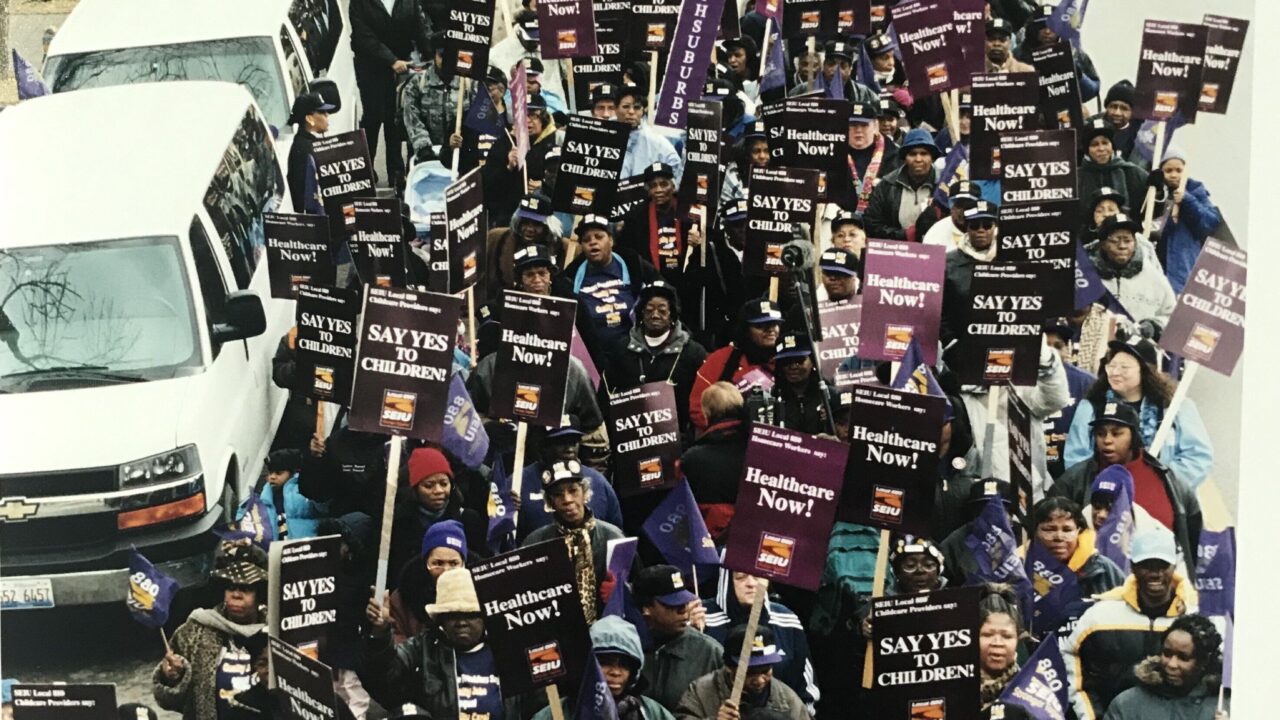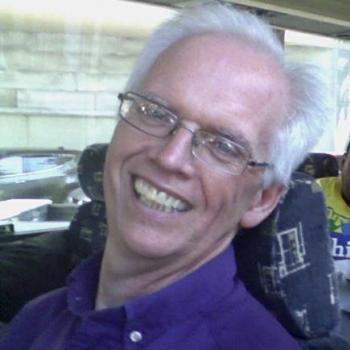The overwhelming 97 percent union vote margin by a group of over 43,000 childcare providers in California is the most recent victory in a decades-long movement of hundreds of thousands of home-based childcare providers across the United States. It is also one of the largest victories for labor unions in the U.S. in recent history. But the organizing campaign had far less auspicious beginnings. In late 1995, Audrey Harris, a homecare worker in Chicago, approached me at the end of our monthly membership meeting: “Keith, you think homecare wages are low? You should organize home daycare!”
“What’s that?” I replied, distracted with cleaning up after the meeting.
Mrs. Harris soon caught my attention with her description of home childcare providers, the overwhelming Black and Latinx women who cared for the children of low- and moderate-income families in their homes – who were getting reimbursed by the state of Illinois for as low as $5-$10 per child per day. She explained that they had no benefits like health insurance, paid holidays, paid sick days; they had no training and no respect. They were, in effect, being paid sub-minimum wages – sometimes as low as $1-$2 per hour.
The more Mrs. Harris spoke, the more interested I grew, but I was troubled by what seemed to be the insurmountable obstacles to organizing these workers.
I discussed what I found from Mrs. Harris with our leadership and staff, and we agreed we needed more information to see if it was possible to organize these folks.
The more research we did, the more overwhelming the organizing obstacles seemed to be. Home childcare workers were considered “independent contractors,” a legal construction designed to keep them low-waged and powerless. Remarkably, the subminimum wage; the lack of coverage under Social Security, the Fair Labor Standards Act (FLSA), the National Labor Relations Act (NLRA), or the Illinois State Labor Relations Act (SLRA); the waiting months for their late checks; the lack of training; the racism; the sexism; and all the other indignities they were forced to endure were legal.
We had confronted similar obstacles when we organized thousands of homecare workers – who cared for seniors and people with disabilities in their homes and who many thought could not or should not be organized. But this home childcare system seemed even more impossible to navigate. At least homecare workers had set hours and an hourly wage; childcare providers didn’t even have that.
But these legal obstacles didn’t intimidate our members. As one of our homecare workers put it: “Slavery was legal, too, and that didn’t stop us!” These were people whose parents and grandparents had fought Jim Crow and traveled north to Chicago in search of the promised land. They found a different, more nuanced Jim Crow headed by a man named Daley, but that didn’t stop them from organizing, and neither would this racist childcare system stop their children and grandchildren.
As usual, the members were right. We had one thing on our side that the accrued forces of the state and federal government hadn’t counted on: we had the people!
We got to work.
The more we asked our members, the more we found that there were hundreds, if not thousands, of homecare workers who were also home childcare providers. And we did what we did in homecare, except with a few tweaks: we house visited as many childcare providers as we could, obtained a list, and signed people up for the union; we did fundraisers to support our organizing; and we collected dues.
We hand collected dues at first, but eventually signed up over 1,500 childcare providers on bank drafts of $10-20 per month. Five hundred of these folks also signed a bank draft of $5 per month for our political fund. These ongoing dues payments helped to make our childcare field organizing team self-sufficient and added tens of thousand of much-needed dollars to our political fund. Hundreds of additional members paid their dues in cash.
We took action. If our members’ checks were late, we called through our lists, loaded up school buses, and headed to the state building to demand payment
If a city or a town tried to pass racist and sexist laws to limit state-supported, home-based childcare, we loaded up the buses again, and we marched into the City Council or town meetings and demanded they rescind that law.
If the reimbursement rates from Springfield were too low — and they were always ridiculously low — childcare providers organized busloads to march on the Capitol in Springfield demanding rate increases.
Even though we had no chance under what was then the law to have a recognized union, we did what workers in our local — SEIU Local 880 — had done for years: we organized, and we acted like a union anyway, despite what the law said.
If the state labor board and national labor board refused to allow us to organize because our workers were “independent contractors,” we kept going back to the legislature – again and again, until in 2005, after ten years of organizing, we made them pass a bill giving us collective bargaining rights.
None of this would have been possible without our great leaders.
People like Lula Bronson, originally from Turrell, Arkansas and the daughter of a sharecropper. A widow who raised eight children, she picked cotton as a child. When she got off a train in Chicago in 1970, she did whatever minimum wage work she could until she became a homecare worker and a leader in the fight to organize her homecare agency. She later became a childcare provider and was a key leader in this ten-year fight to organize the over 49,000 home childcare providers in Illinois. She eventually rose to become the Vice President of SEIU Local 880.
Some higher-ups in the labor movement thought organizing childcare workers was a lost cause. One snickered: “Childcare workers! Could you have picked a group of workers who are more marginal and powerless?!”
But the Illinois home childcare providers had the last laugh. After ten years of organizing in 2005, they won the largest union election in Illinois history and one of the largest union elections in U.S. history. An overwhelming majority of the over 49,000 home childcare providers voted to be represented by SEIU Local 880.
In 2006, they marched into the Governor’s office singing “Victory Is Mine!” to sign the first home childcare providers union contract in U.S. labor history.
And they won significant improvements in their contract: a rate increase of 36 percent in their first contract and even more in subsequent agreements, employer paid health coverage, paid training, quality bonuses for increased training, and more.
But they didn’t stop there: when they found that there were hundreds of thousands of home childcare providers in other states who wanted to organize, they traveled there as well, helping those childcare providers to organize. Following their success, eight other states saw unionizing victories: New York, New Jersey, Oregon, Washington, Rhode Island, Connecticut, Massachusetts, and Maryland.
And now California. Just like in Illinois in 1995, the California childcare workers won their union election — after a 17 year fight. They join the well over 100,000 home childcare providers across the country who have won their unions in the past 17 years — one of the largest successful organizing campaigns in the modern labor movement.
Everyone has called these workers “essential” and “heros.” They deserve to be treated as the essential heroes they are — and with their union, they will!

